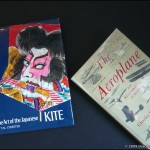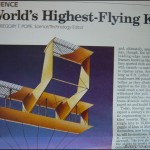On a recent trip to the National Art Education Association convention, held this year in Minneapolis, MN, I was reminded of the value of walking away from the crowds and finding that special “happy hunting ground” for those of us interested in all things kite. On trips to Japan, these getaways almost always involve ukiyo-e stores, where an hour or so of browsing might bring to light a homeless kite print. In the United States, it’s a little harder to narrow the search; antique stores usually just have too much “stuff” (remember, stuff is the junk you keep, junk is the stuff you throw away!), gift stores often have contemporary “stuff,” but it’s the obscure, overlooked things that make for a happy hunting ground.
So it was in Minneapolis, where, on the main downtown thoroughfare was a bookstore, James and Laurie Booksellers. Not any ordinary bookstore, however, a bookstore of organized chaos, with books filed and unfiled, and everywhere! This is the type of store where you might find anything – in fact, one of the specialties of this one is World War One posters, absolutely amazing imagery, and very reasonably priced. I was lucky enough to find a first edition, The Art of the Japanese Kite, by Tal Streeter, as well as a 20th century print, Windy Hill, by American artist, Lawrence Beall Smith.
The trip reminded me of a couple others where unlikely trips into a vintage bookstore bore fruit. The first was in Salt Lake City – not a hotbed for antiques or kites – but in another wonderfully eclectic bookstore, Sander’s Rare Books, I found a Smithsonian Institution publication from the early 20th Century. In it was a bibliography of articles about kites. Gold for the serious kite researcher. Finally, the book on my shelf that reminded me of the others, an historical look at the airplane by noted historian Charles H. Gibbs-Smith, The Aeroplane, an Historical Survey. While this book is not as kite-specific as the other two, it came with some bonuses. About a dozen clippings, collected by the aeronautical enthusiast who owned the book, directly related to subjects in the book. Gibbs-Smith has a wonderful section in the book, Gliding, the Prelude to Practical Flying, 1890 – 1903, that was supplemented by a clipping stuffed into the book by its previous owner. Another clipping happens to be the 1996 Popular Mechanics article, World’s Highest-Flying Kite, by Gregory Pope.
The moral to this short diversion is, always take the time to explore a potential source of rare kite material. With the internet upon us, the more chaotic a store the better (although Laurie’s in Minneapolis had an amazing amount of their inventory online), talk with the owners, they remember where the treasures are hidden, keep up the active search.
Scott Skinner
Be sure to visit the Kite Lines magazine archives for over 30 years of classic and modern kite articles,
plans, interviews and much more, all in PDF format.





